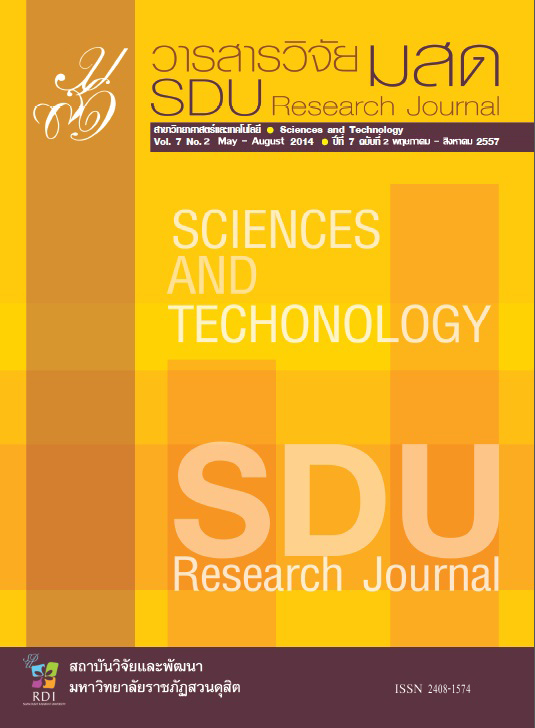ผลของการใช้ระบบชลประทานแบบหยดและปุ๋ยเคมีต่อการเติบโตและผลผลิตของมันสำปะหลังที่ปลูกปลายฤดูฝน
Keywords:
ระบบชลประทานแบบน้ำหยด, ปุ๋ยเคมีทางดิน, ปุ๋ยเคมีทางระบบน้ำ, มันสำปะหลังAbstract
บทคัดย่อ
การวิจัยในแปลงทดลองที่มีเนื้อดินประเภทดินร่วนปนทรายมีการวางแผนการทดลองแบบ Randomized Complete Block design 3 ซ้ำ แต่ละซ้ำประกอบด้วย ตำรับทดลองร่วม (treatment combinations) ที่ประกอบด้วยปัจจัยที่ศึกษา 2 ปัจจัย คือ ปัจจัยเกี่ยวกับระบบชลประทาน 3 ระบบ โดยมีระบบเกษตรน้ำฝนเป็นปัจจัยเปรียบเทียบ รวมทั้งหมด 4 ระบบ ดังนี้ 1) ไม่ให้น้ำ 2) ให้น้ำชลประทานแบบหยดบนผิวดิน 3) ให้น้ำชลประทานแบบหยดใต้ดินลึก 10 เซนติเมตร และ 4) ให้น้ำชลประทานแบบหยดใต้ดินลึก 40 เซนติเมตร และการใส่ปุ๋ยเคมี 4 ตำรับทดลอง ได้แก่ 1) ไม่ใส่ปุ๋ยเคมี 2) ใส่ปุ๋ยเคมีทางดินสูตร 15-7-18 อัตรา 50 กิโลกรัมต่อไร่ 3) ใส่ปุ๋ยเคมีทางท่อ อัตรา 50 กิโลกรัมต่อไร่ และ 4) ใส่ปุ๋ยเคมีทางดิน 1 ใน 3 และทางท่อ 2 ใน 3 อัตรา 50 กิโลกรัมต่อไร่ การทดลองมีวัตถุประสงค์เพื่อเปรียบเทียบประสิทธิภาพของระบบชลประทานและการใส่ปุ๋ยเคมีต่อการเติบโต ผลผลิตและการดูดใช้ธาตุอาหารหลักของมันสำปะหลังพันธุ์ห้วยบง 80
มันสำปะหลังตอบสนองทางด้านน้ำหนักสดของต้นส่วนเหนือดิน ผลผลิตหัวสด และการดูดใช้ธาตุอาหารหลักต่อการชลประทาน ระบบชลประทาน การใช้ปุ๋ยเคมี และวิธีการใส่ปุ๋ยเคมีอย่างมีนัยสำคัญ การใช้ระบบชลประทานแบบน้ำหยดใต้ดินลึก 40 เซนติเมตรและวิธีการใช้ปุ๋ยเคมีทางระบบน้ำ อัตรา 50 กิโลกรัมต่อไร่ มีประสิทธิภาพต่อการเพิ่มการเติบโตของต้นส่วนเหนือดิน ผลผลิตหัวสดและการดูดใช้ธาตุอาหารหลักจากปุ๋ยเคมีที่ใส่ลงในดินมากที่สุด และการใช้ระบบชลประทานแบบน้ำหยดใต้ดินลึก 40 เซนติเมตรร่วมกับวิธีการใส่ปุ๋ยเคมีทั้งหมดทางระบบน้ำอัตรา 50 กิโลกรัมต่อไร่ ให้ผลผลิตหัวสดที่ระยะ 12 เดือนหลังปลูก เฉลี่ยสูงสุด 8,154 กิโลกรัมต่อไร่
คำสำคัญ : ระบบชลประทานแบบน้ำหยด ปุ๋ยเคมีทางดิน ปุ๋ยเคมีทางระบบน้ำ มันสำปะหลัง
Abstract
A field experiment was conducted in sandy loam soil, using the experimental design as randomized complete block with 3 replications, each replication was consisted of 14 treatments, out of which 12 treatments were derived from the combinations of 2 studied factors namely 1) rain-fed 2) surface drip irrigation 3) sub – surface drip at 10 cm. 4) sub – surface drip at 40 cm. and 4 fertilizing methods that comprised 1) unfertilized 2) soil application of fertilizer grade 15-7-18 at 50 kg / rai 3) fertigation of fertilizer grade 15-7-18 at 50 kg/rai and 4) soil application at 2/3 and fertigation at 1/3 of 50 kg /rai of fertilizer grade 15-7-18. The objectives of the experiment were to study the relative effectiveness of irrigation and fertilizing methods on growth, yield and nutrients uptake of cassava variety Huaibong 80.
The results obtained revealed marked responses of cassava with respect to fresh top weight, average weight of fresh tuber and NPK uptake to irrigation, irrigation systems, fertilization and fertilizing methods. The highest increment in terms of top growth, root yield, nutrients uptake, water and fertilizer uses efficiencies as affected by irrigation systems and fertilizing methods were evident with the uses of sub – surface drip at 40 cm. and the fertigation of fertilizer grade 15-7-18 at 50 Kg/rai. Moreover, the combinded effects of these two treatments had also given the hightest tuber yield of 8,154 kg per rai.
Keywords : Drip irrigation system, Soil application, Fertigation, Cassava








